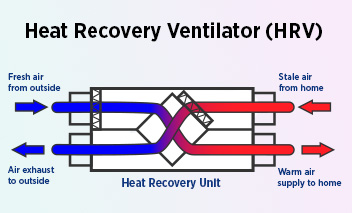Best Strategies to Care For Your HRV System
The All-Inclusive Overview to the Uses of Heat Recovery Ventilation in Modern Buildings
Heat Recovery Ventilation (HRV) systems stand for a substantial innovation in developing innovation (HRV Heat Recovery Ventilation). They supply an approach for exchanging stale interior air with fresh outdoor air while decreasing energy loss. This method not just boosts interior air high quality yet also adds to energy efficiency in both property and industrial structures. Comprehending the various applications and benefits of HRV can reveal its critical function in modern-day design and sustainability efforts. The effects of this technology deserve discovering better
Recognizing Heat Recovery Ventilation Equipments

Although many modern structures focus on energy effectiveness, recognizing warmth healing air flow (HRV) systems is important for enhancing interior air top quality and reducing energy usage. HRV systems work by transferring warm from stale indoor air to inbound fresh air, effectively maintaining comfortable indoor temperature levels while minimizing power loss. These systems consist of a warm exchanger, fans, and ductwork that help with the flow of air. During winter season, HRV systems catch and reuse heat from the outbound air, while in summertime, they can assist cool incoming air. By continuously trading air, HRV systems additionally lower moisture and the focus of indoor pollutants. Proper installment and upkeep of HRV systems are crucial for their performance and efficiency in improving general building performance and comfort.
Benefits of Heat Recovery Ventilation
Heat recovery ventilation systems use various benefits that boost both power efficiency and indoor air quality in modern structures. By recording and reusing energy from exhaust air, these systems significantly reduce heating & cooling expenses, leading to lower power consumption. In addition, they preserve a steady circulation of fresh exterior air, minimizing the threat of interior air pollutants and irritants. This continual exchange assists regulate moisture degrees, avoiding mold and mildew growth and ensuring a much healthier living setting. Additionally, HRV systems contribute to sustainability goals by decreasing total carbon footprints. Their capacity to enhance air flow without compromising thermal comfort makes them a valuable enhancement to modern structure design, promoting both economic and ecological benefits.
Applications of HRV in Residential Structures
As homeowners progressively prioritize energy performance and indoor air quality, the applications of warm recuperation ventilation (HRV) systems in property structures have actually come to be much more common. HRV systems are particularly helpful in snugly sealed homes, where keeping fresh air flow is vital for avoiding wetness build-up and interior pollutants. They efficiently why not check here transfer warmth from outgoing stale air to incoming fresh air, decreasing energy costs connected with cooling and heating. Furthermore, HRVs can improve convenience levels by regulating humidity and temperature. They are also adaptable for various residential designs, including single-family homes and multi-unit structures. On the whole, incorporating HRV systems sustains sustainable living methods while making sure a much healthier indoor atmosphere for residents.
HRV in Commercial and Industrial Setups
In business and industrial setups, the implementation of warm healing air flow (HRV) systems has actually ended up being progressively critical for maximizing energy performance and maintaining air high quality. These systems efficiently move warmth from exhaust air to incoming fresh air, reducing the demand for extra home heating or air conditioning. This not only reduces power expenses but likewise contributes to sustainability efforts. Industries such as manufacturing, warehousing, and office structures profit significantly from HRV systems, as they help manage temperature and moisture levels, making certain a comfy and find out here effective atmosphere. In addition, HRV systems help in eliminating contaminants and excess dampness, improving indoor air top quality. As regulations around air top quality end up being more stringent, the adoption of HRV modern technology is most likely to grow, making it an essential part of modern business and industrial framework.
Future Trends in Heat Recovery Ventilation Modern Technology

Frequently Asked Inquiries
Just How Does Heat Recovery Ventilation Influence Indoor Air High Quality?
Heat recovery ventilation substantially boosts indoor air high quality by continuously exchanging stagnant interior air with fresh outside air while recuperating power. This procedure reduces contaminants, keeps excellent humidity degrees, and ensures a healthier setting for occupants.
Can HRV Solutions Be Set Up in Existing Buildings?
HRV systems can certainly be installed in existing structures. Retrofitting may need modifications to ductwork and ventilation layouts, yet it significantly improves power effectiveness and indoor air top quality, making it a feasible option for older frameworks.
What Maintenance Is Needed for HRV Solutions?

Exist Details Climates Where HRV Is More Effective?
Heat recovery ventilation systems are particularly efficient in climates with significant temperature level distinctions in between periods. These systems enhance energy effectiveness by recouping warmth from exhaust air, making them perfect for both cold and moderately warm atmospheres.
How Do HRV Solutions Affect Power Costs?
